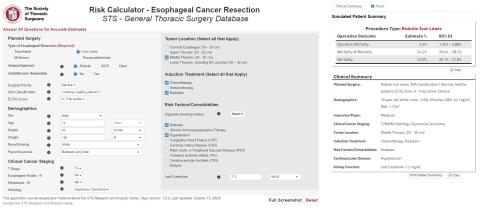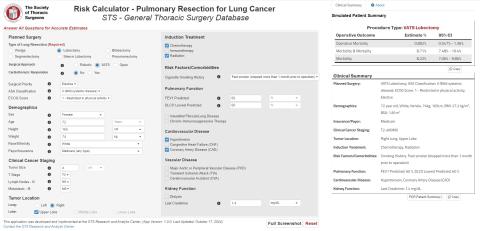The Society of Thoracic Surgeons has released two new risk calculators designed to improve decision-making in thoracic surgery. These advanced tools, developed using contemporary data from the STS General Thoracic Surgery Database (GTSD), offer precise preoperative risk estimations for esophagectomy for cancer and pulmonary resection for lung cancer.
The new risk calculators are engineered to provide surgeons with individualized risk assessments based on specific patient factors, such as tumor characteristics, comorbidities, and the type of procedure performed. As patient factors are added by the user, the risk estimates of morbidity and mortality are dynamically calculated along with 95% confidence intervals. The goal is to provide thoracic surgeons with intuitive resources that can support preoperative decision-making and improve quality of care.
A key feature of the new models behind the risk calculators is ease of use. The process has been streamlined to minimize the number of input variables for surgeons. Dr. Christopher Seder, chair of the STS General Thoracic Surgery Database Task Force, explained, “We’ve reduced the number of input variables required to make the process as quick as possible for surgeons to access the information they need and assess the risks for their patients. This ensures the tools are efficient and easily deployable in busy clinical environments.”
Esophagectomy for Cancer Risk Calculator

The esophagectomy for cancer risk model used to power the new risk calculator has been updated to include data from 18,503 patients across 254 hospitals, a cohort four times larger than previous models. The expansion allows for more precise estimations and broader applicability. Added risk factors include preoperative cancer staging and body surface area. The new model supports an interactive, web-based calculator for preoperative decision-making, quality improvement, and performance assessment.
Dr. Seder emphasized the importance of this advancement: “The esophagectomy for cancer risk calculator represents a significant leap in personalized care for thoracic surgery patients. Built with a more diverse patient cohort and using only preoperative variables, the tool provides surgeons and patients with a comprehensive and precise view of predicted outcomes.”
Resection Risk Calculator for Lung Cancer

Similarly, the pulmonary resection for lung cancer risk calculator is based on an updated risk model using data from 140,927 patients at 337 hospitals from 2015 to 2022. This model reflects modern surgical trends and techniques, including the increasing prevalence of minimally invasive and robot-assisted procedures.
“The new risk calculator for pulmonary resection offers superior performance and applicability, especially for high-risk patients,” said Dr. Seder. “Surgeons will receive individualized Information succinctly, which can help guide decision-making for their patients.”
Advancing Patient Care
These new risk calculators are designed to facilitate more individualized patient care by offering detailed risk estimates tailored to each patient’s unique profile. According to Dr. Seder, as more information is made available to a surgeon through the tools, the risk for that patient may change, which is critical to decision-making.
“Medicine is moving towards customized therapy, and these tools are an adjunct that allows surgeons to provide individualized care,” explained Dr. Seder. “Instead of looking at all the data as a whole, we can now calculate an individual’s risk, providing a more personalized approach to patient care.”
Dr. Farhood Farjah, University of Washington/Fred Hutchinson Cancer Center and endowed chair in lung cancer research, previewed the risk calculators and said, “The thoracic surgery risk calculators provide an unprecedented opportunity to estimate a patient’s risk of morbidity and mortality after pulmonary resection or esophagectomy using high quality, audited, clinically granular, and procedure-specific and disease-specific data. Not only does the risk calculator provide an estimate of risk, it provides an estimate of the uncertainty of that risk. This tool can be used to advance patient-centered care when partnered with other sources of information on the benefits of surgery, as well as the risks and benefits of alternative interventions.”
The thoracic surgery risk calculators add to the breadth and depth of STS’s suite of adult cardiac surgery risk calculators, including the Risk Calculator for Surgical Repair of Primary Mitral Regurgitation, the Isolated Tricuspid Valve Surgery Risk Calculator, the SAVR After TAVR Risk Calculator, and the Multi-Valve Surgery Risk Calculator.
All risk calculators are available as interactive online tools at STS.org, providing surgeons with valuable resources to enhance patient care.